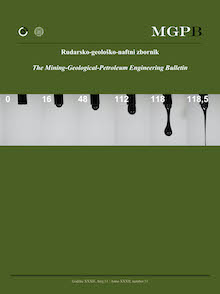Intelligent natural dump flooding well - Case study from the area of the western Persian/Arabian Gulf and possible application in the Croatian mature oil field Beničanci
DOI:
https://doi.org/10.17794/rgn.2020.4.3Keywords:
natural dump flooding well, intelligent well completion, subsea wellhead, mature oil field, IORAbstract
In the process of oil reservoir waterflooding, natural water dump flood technology for reservoir pressure decline prevention is considered as an unconventional but technically less demanding, more economical and safer method in comparison to surface power water injection. With natural dump flood technology, a single well serves as a water producer from a water bearing layer (aquifer) and simultaneously through gravity and the pressure difference between the aquifer and the depleted oil reservoir, it serves as a water injector inside the oil reservoir without expensive and complex injecting water treatment facilities at the surface. With the use of such technology and the running of intelligent well completion, it allows for the permanent monitoring of water production, injection rates and temperature inside the chosen reservoir. In addition, in offshore operations, the use of a subsea wellhead with a mud line suspension system allows for the placing of the injector well at the best predetermined position for water injection in a targeting reservoir and, together with an efficient subsurface acoustic data acquisition system, leads to better reservoir management and well integrity improvement. The overview and critical reflection of the drilling and intelligent completion of a natural dump flooding well for reservoir pressure support in partially depleted oil reservoirs in the Persian/Arabian Gulf has been given, referring to both their preparation and execution phase. The possibility of applying natural water dump flood was also considered in the Croatian onshore Beničanci oil field through a pilot project of water injection into the Be-62 well.
Downloads
Published
How to Cite
Issue
Section
License
Copyright (c) 2020 authors and journal

This work is licensed under a Creative Commons Attribution 4.0 International License.
Creative Commons-BY
Authors who publish with this journal agree to the following terms:
In agreeing this form, you certify that:
- You read the ethical codex of the RGN zbornik available at journal web.
- You submitted work is your original work, and has not previously been published and does not include any form of plagiarism.
- You own copyright in the submitted work, and are therefore permitted to assign the licence to publish to RGN zbornik.
- Your submitted work contains no violation of any existing copyright or other third party right or any material of an obscene, libellous or otherwise unlawful nature.
- You have obtained permission for and acknowledged the source of any illustrations, diagrams or other material included in the work of which you are not the copyright owner.
- You have taken due care to ensure the accuracy of the work, and that, to the best of your knowledge, there are no false statements made within it.
- All co-authors of this submitted work are aware of, and in agreement with, the terms of this licence and that the submitted manuscript has been approved by these authors.
Publication licence
You retain copyright in your submitted work, according to journal license policy (CC-BY). By signing this form you agree that RGN zbornik may publish it under the publication licence. In summary the licence allows the following:
Anyone is free:
- To copy, distribute, display, and perform the work.
- To make derivative works.
Under the following conditions:
- The original author must always be given credit.
- The work may not be used for commercial purposes.
- If the work is altered, transformed, or built upon, the resulting work may only be distributed under a licence identical to this one.
Exceptions to the licence
In addition to publishing the work printed under the above licence, RGN zbornik will also enable the work to be visible online.
The journal editorial can change the licence rules anytime but it cannot retroactively restrict author(s) rights.


